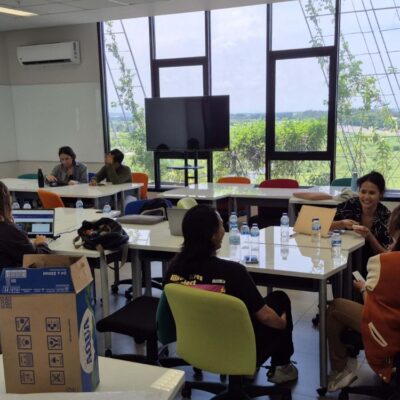Attitudes towards Chinese language and China Studies in both Australia and Aotearoa New Zealand have been affected by the deterioration in their respective bilateral relationships with China over the past few years. This has impacted Chinese language educators and students in a variety of ways.
We conducted an online survey in 2022 to investigate aspects of the bilateral relationships that have impacted educators’ work and relationships as they attempted to negotiate challenges arising from the changing dynamics in the relationships. We present the main findings here.
Background
Improved levels of Chinese language proficiency and a better understanding of China have been viewed as key elements in building the bilateral relations of both nations with China.
In Australia, this is reflected in government policies and education initiatives over the last three decades. An important milestone was Asian languages and Australia’s economic future (1994), referred to as the Rudd Report, which resulted in the National Asian Languages and Studies in Australian Schools (NALSAS) program, (1995-2002), and its successor, the National Asian Languages and Studies in Schools Program (NALSSP, 2008-2012), both of which provided financial support to increase the uptake of Chinese language learning in schools. The Australia in the Asian Century White Paper, published in 2012, also identified Mandarin as a priority language and set targets for the business community and public servants to have experience and knowledge of Asia. Shortly after, the New Columbo Plan (NCP, 2014) was announced to encourage and enable student mobility for study and internships in Asia, including China.
Several reports which evaluate the current state of Chinese language and China Studies in Australia, and propose strategies for their improvement, have also been produced by scholarly and professional associations during this timeframe. Notable among these are Maximizing Australia’s Asia knowledge: Repositioning and renewal of a national asset (released in 2002 by the Asian Studies Association of Australia), Building Chinese language capacity in Australia (released in 2016 by the Australia-China Relations Institute), Australia’s Asia education imperative (released in 2022 by the Asian Studies Association of Australia) and, most recently, Australia’s China knowledge capability (released in 2023 by the Australian Academy of the Humanities). These reports all highlighted ongoing issues in the provision of Chinese language and studies programs and recommended greater financial support and national coordination of efforts to improve tertiary programs in Chinese language and China related courses, improved Chinese teacher training, and greater opportunities for in-country studies and experiences.
In Aotearoa New Zealand, learning Mandarin Chinese has been promoted, but there is not much focus on strengthening knowledge and literacy development to better understand China. The Waite Report (1992), for example, highlighted the need for New Zealanders to be able to speak languages such as Mandarin, while the Education for the 21st Century policy by the Ministry of Education (1994) established National Education Aims that set targets for students in Years 7-10 to learn an additional language, including Mandarin. This was followed by Learning Languages as one of the eight learning areas of the New Zealand Curriculum in 2007, which nominated Mandarin as a main targeted language. The Tui Tuia Learning Circles at the University of Auckland created a national language advisor to facilitate Mandarin teachers’ professional development and language proficiency, as well as to assist with Mandarin teaching assistants/aides in schools.
In the tertiary sector, the reports Knowing Asia: The challenge for New Zealand’s tertiary education sector produced by the New Zealand Asian Studies Society, and the New Zealand China Council’s A crisis of complacency? Chinese language learning in New Zealand provided analysis of Chinese language and China Studies in the country and called for them to be expanded.
Changing bilateral relations between Australia and China and Aotearoa New Zealand and China
While the goals of these policies and education initiatives have yet to be fully realised, it is notable that initial efforts to achieve Chinese language proficiency and knowledge of China in both countries took place in the context of their generally positive political and economic relations with China several decades ago. However, there has been a general deterioration of each country’s relationship with China in recent years due to trade disputes and diplomatic disagreements. Concerns about China’s domestic and international policies and actions, including the treatment of the Uyghur ethnic minority in Xinjiang, territorial disputes in the South China Sea, China’s suppression of protests in Hong Kong and its handling of the early stages of the COVID-19 pandemic, have also negatively impacted the way the Chinese government is perceived in Australia and Aotearoa New Zealand.
In recent years concerns have emerged in government and the public about the nature of and rationale for teaching and learning of Chinese. For example, in Australia, the purpose of Chinese language learning and teaching, and the content of Chinese language subjects, is sometimes seen as interference by the Chinese government and is portrayed as a potential threat to national and cultural identity in media and teacher discourses. While Aotearoa New Zealand continues to promote learning Chinese in educational and community settings, concerns have been raised over the implications for schools and students of increasing numbers of Mandarin Language (Teaching) Aides/Assistants (MLAs), sponsored by the Chinese government, resulting from the trade deal between Aotearoa New Zealand and China. The celebration of Mandarin only rather than embracing other languages spoken by local Chinese New Zealanders during the annual Chinese Language Week also raised concerns.
Concerns are especially intense when Chinese language learning and teaching is conducted through Chinese government-sponsored initiatives, Confucius Institutes and Confucius Classrooms. In 2018, the government of the state of New South Wales (Australia’s most populous state) reviewed its Confucius Classrooms program coordinated by the Confucius Institute in the state’s Department of Education. While the review found no ‘evidence of actual political influence being exercised’, it did identify ‘a number of specific factors that could give rise to the perception that the Confucius Institute is or could be facilitating inappropriate foreign influence in the department’. The institute and the 13 Confucius Classrooms connected to it were closed in 2019. China denounced this decision as damaging relations between the two countries, with Foreign Ministry former spokesman Geng Shuang saying, ‘we hope the Australian side will respect their Chinese partner and do more things to strengthen mutual trust’.
Confucius Institutes were included in Australia’s Foreign Relations Act (2020) and the subsequent review of foreign interference on university campuses. The Parliamentary Joint Committee on Intelligence and Security’s inquiry into national security risks affecting the Australian higher education and research sector recommended that universities make the details of their Confucius Institute agreements available to the public and ensure greater control over staffing, curriculum and academic freedom. It further recommended that Australia’s Foreign Minister exercise veto powers over any agreement deemed not in the national interest.
Findings of the online survey
The survey explored factors that have affected individuals’ views, at a personal and professional level, on the influence of local Confucius Institutes, mainstream media and internationalisation in education. Salient factors, such as workplace (mostly school or university), teaching content, nationality, language proficiency etc., which influenced their perceptions of and responses to the current geopolitical context, were explored.
The survey was widely distributed between March and September 2022 through various channels, including university and research centre networks, education advocacy groups and organisations, and teacher professional communities in Australasia. The survey was specifically targeted at individuals who were directly involved in teaching Chinese language or China Studies, as well as those who had encounters with Chinese international/background students and engaged with China or China-related activities at the workplace or interpersonal level.
A total of 191 educators responded: 98 were affiliated with tertiary/university, 66 from schools, six in research institutes and think tank organisations, and five working in government departments. The majority of respondents were based in Australia (n=89), with approximately one third located in Aotearoa New Zealand. Respondents were also well-educated (mostly with a postgraduate degree) and multilingual speakers (approximately 65 percent reporting proficiency in both English and Mandarin Chinese for professional purposes).
Respondents (more than 55 percent) based in Australia indicated they believed that economic issues and regional security issues impacted on the bilateral relationship with China. Specifically, they expressed their concern regarding China’s Belt and Road Initiative, tariffs imposed by China on Australia’s exports, and the recently announced (at the time of the survey) AUKUS agreement. On the other hand, respondents based in Aotearoa New Zealand were apprehensive about the fragility of the current relationship due to issues such as human rights concerns but did not identify any particular issues that had impacted the Aotearoa New Zealand and China relationship.
There was consensus among respondents who held a strong view that the Australia, Aotearoa New Zealand and China relationships have restricted the establishment of new collaboration, especially in international education and in-country study and exchange at school and university levels. In the school sector, teachers reported noticeable changes in their feelings about and strategies toward tackling the challenges they faced as a result of the evolving relationship, such as negative attitudes toward Chinese language programs in the community, and uncertainty about the sustainability of these programs.
Respondents expressed a sense of fear, cautiousness, and anxiety when they inevitably encountered classroom discussions surrounding sensitive topics related to China. The following provide a snapshot of the respondents’ personal experiences of day-to-day classroom practice in schools:
- [I] have to avoid more topics than before, have to be cautious what to say and what not to, a lot of unnecessary pressure. (Italics added for emphasis)
- I became increasingly ambivalent and uneasy. On one occasion I wondered whether I had a Chinese informant in my Chinese culture class. My anxiety level increased due to several factors including a past teaching experience in which I was interrogated on my political views by a class representative [i.e. a member of the class coming forward to express a common concern].
- The only thing really is my unwillingness to bring up discussions around Taiwan and Hong Kong.
Respondents were emotionally challenged by increasing sensitivity over what can be safely covered and openly discussed in the learning and teaching context, which significantly disrupted their professional and educational practices. For instance, as reported, they engaged in a degree of self-censorship, with their freedom of expression about or the depth of their analysis of some contemporary issues being restricted, by choice, in order to maintain harmony and a positive perspective on China in their classrooms. They were also sensitive to the needs and interests of their Chinese background and Chinese international students who may feel uncomfortable or challenged when opinions or views which portray China in a negative light are raised in class discussions. Despite these challenges, some felt accountable for addressing and raising awareness of issues, such as concerns over human rights in Xinjiang and the removal of democratic rights and freedoms of the citizens of Hong Kong. They believed that there is need for open discussions on controversial issues. However, it was unclear to them how educators should approach and facilitate meaningful discussions around these sensitive topics in a strategic, professional, and analytical manner.
This respondent shared their approach:
‘I am much more careful to frame lecture content about China with clear evidence and with the preface that I could teach the same history of geopolitics of the nation state for any nation, China is just the one I am most familiar with. I then make sure to do the same critique of Thailand and the US to show that it is not just about China. This is so Chinese students do not feel attacked. I also present a lot of positive contemporary work on Chinese culture alongside my work on minority groups in China to show that I am not biased. Many Chinese students feel very challenged and uncomfortable by this sort of material.’
Respondents from both school and tertiary sectors strongly agreed that the changing dynamics of bilateral relations with China have had a detrimental impact on Chinese language programs and student participation in Australia and Aotearoa New Zealand. Some respondents reported that a number of schools had made a decision to either temporarily or permanently discontinue offering Chinese language programs. Typically, in the Aotearoa New Zealand context, due to the pandemic border closure, there were no new Mandarin Language Aides/Assistants (MLAs) from China to support Chinese teaching at primary and secondary schools. The disappearance of MLAs resulted in insufficient staffing for sustained Chinese program operations in schools. Some respondents reported a decline in interest among students to study Chinese based on their day-to-day teaching practice and observation, such as smaller class sizes, lower enrolments, and challenging retention rate. This decline was also related to the closure of Confucius Classrooms as well as parents’ requests and intervention (such as ‘a reluctance to encourage Chinese learning’). As one respondent explained, ‘We teach across schools, and some (students) requested to drop out of Chinese language [a]nd learn another language instead. School feedback has been the parents don’t want them to [be] involve[d] in learning Chinese.’
School teachers of Chinese in particular also reported some frustration at the broader geopolitical context they find themselves in, expressing a desire to ‘de-politicise’ the teaching and learning of Chinese language and culture in schools. They fear too much focus on sensitive issues and tensions in the relationship was likely to prevent a proper focus on individual person-to-person interaction and intercultural exchange. As one teacher suggested, It is timely to call for ‘a positive educational program on why learning Chinese is particularly important now because of the changes in politics and relationships.’
Implications for Chinese language and China Studies
The survey findings reveal a concern among respondents that tensions in the bilateral relationships, and negative portrayals of China’s policies and practices in local media and the consequent negative perceptions of that relationship in the community, are having a negative impact on educators’ practices and on student interest and engagement in learning Chinese and learning about China.
It is not clear that decline in interest or motivation to learn Chinese is directly due to tensions in the bilateral relationships. The Chinese language is one of the more difficult languages to learn, due primarily to the complexities of its written script which means progress is often slow, especially in low time-on-task contexts. Teachers also feel a need to include culture studies in their Chinese language courses, even with limited time allocation, and feel the need for more time and resources to develop this broader ‘China-literacy’ (a general knowledge of the geography and history of China, and the culture and contemporary society of Chinese communities) alongside basic Chinese language proficiency in their classrooms.
Teachers also often find they need to teach to a range of proficiency levels or prior knowledge and experience in learning Chinese in the Chinese classroom, as Mandarin Chinese is now the most common language spoken at home in Australia, after English. China was also the largest source of international students intake into Australian schools until 2020. Novice second language learners often find themselves learning Chinese alongside students who speak Chinese at home, some of whom may have begun their school education in China prior to migration. Typically, students with Chinese background bring diverse levels of knowledge about modern China and of contemporary and traditional culture in China. Thus, the teaching of Chinese and discussions of Chinese culture and contemporary society need to be sensitive to students’ prior knowledge and experience, and their sense of affiliation with the culture, and with mainland China in particular.
With larger student cohorts, Chinese programs at tertiary level have more opportunity to differentiate between learner groups, and learners have a wider range of specialised courses which they may take to develop their language proficiency and ‘China literacy’. However, the issues of how Chinese background students may respond to open discussions on aspects and representations of Chinese culture and contemporary society in these courses still prompts academics to think carefully about what topics they cover and what level of discussion they encourage.
Overall, the data indicates a general view that, as with other Asian languages of national significance, there is a need for increased advocacy in promoting the importance and value of learning Chinese in Australia and Aotearoa New Zealand. Given the complex dynamics in the relationships at present however, there does appear to be a need to promote the study of Chinese language and culture at schools and universities as an interesting and worthwhile educational experience in itself, somewhat detached from career pathways, the national interest, and the broader geopolitical contexts in which we currently live.
It is timely to undertake more research to explore whether perceptions of an apparent decline in interest in the learning of Chinese (as opposed to active resistance to doing so) may have more to do with the challenges of learning Chinese, of the nature of what is being taught and the methods of doing so, rather than attributing the decline to the geopolitical context in which the learning takes place.
The study of the history and geography of China, and the culture and contemporary society of Chinese communities in Asia and our region, also needs to be more holistic and cross curricular, targeting the broader school community, beyond just the Chinese language classroom. A 2023 report published by Australian Curriculum for Humanities and Social Sciences (HASS) highlighted the challenges of designing a broad scope curriculum when a targeted country or region specific focus across the years of schooling is probably desirable. The revised curriculum for Geography in Years 7-10 makes only one reference to China in its required content descriptions, and 10 references in its advisory content elaborations. There are no references to China in the History, and Economic and Business curriculum content descriptions, but 25 references in History elaborations, mostly as a possible case study in different historical periods. Only one reference to China appears in the contemporary Globalising World substrand. There are no elaborations referring to China in the Economic and Business curriculum Years 7-10.
What this study has shown is a need to rethink and reframe the rationale for learning Chinese language in our local contexts. We firstly need to consider ways to develop a broader China-literacy in school education that does not depend largely on the Chinese language teacher to include these studies in a language program. We also need to pay less attention to the instrumental value to the nation of learning Chinese, and focus more on the personal educational, and social benefits that learning the language and its associated cultures; benefits that are also a part and parcel of the Australian social and linguistic landscape, and not just of its most significant trading partner.
By shifting the focus away from China as the object of study, a broader approach to Chinese language studies and China-literacy would need to place more value on the linguistic and cultural diversity within our local Chinese communities, including the different languages spoken and used, and their associated cultures, and traditions. Together with comparisons and contrasts between Mandarin and other languages spoken and used by local Chinese communities in Australia and Aotearoa New Zealand and diverse Chinese communities elsewhere, this would highlight the intrinsic vitality and appeal of Chinese as a local language as well as a language of global importance.
Authors: Dr Grace Yue Qi, Andrew Scrimgeour and Dr Jeffrey Gil.
This research was supported by the Australia/China relations and Higher Education Research Network at Deakin University, Melbourne, Australia. It is part of an ongoing project about the effects of relations with China on education.
Image copyright: Andrew Scrimgeour.




